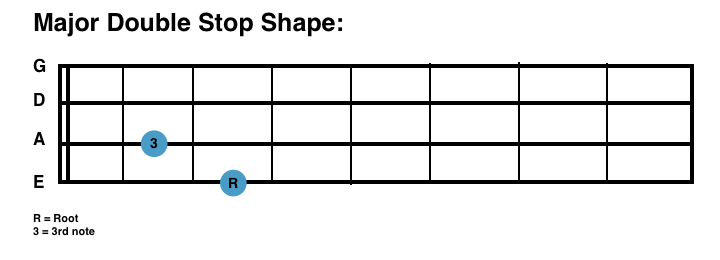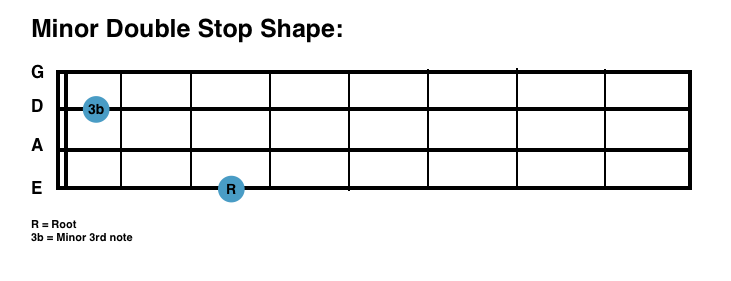Back when I was just getting started on bass, I was equally interested in music composition and writing music beyond just bass guitar. But what was very frustrating at the time was that I really only knew how to play bass. Just starting out, bass guitar was the only instrument I had in my arsenal. I didn’t have a more ‘traditional’ composition instrument like a guitar or piano to learn on or really express ideas with.
Despite that, I had all these other musical, non-bass guitar ideas in my head that needed to get out and boy did they need to come out.
It didn’t take long for me to realize that when life gives you lemons, make lemonade. Bass guitar, I soon discovered, was just as powerful as any other instrument out there for writing songs on – even chords (or at least the rough sketches of chords, anyway).
In this article, we’re going to cover double stops on bass guitar, arguably one of the most underutilized techniques in a bassist’s tool box.
We’re going to cover:
- what are double stops
- how to use double stops and
- my experience using double stops both for band-oriented songwriting as well as writing concert music in high school
Bass Guitar Double Stops: What Are They?
Double stops are 2 notes of a chord: the root and the third. On a standard 4 string bass in standard tuning (EADG), identifying where the major 3rd note and the minor 3rd relative to a given root note is very simple:


Double stops are an excellent technique to add additional body to chords and can contribute to the existing harmony of your band.
My Experience: Using Bass Guitar and Double Stops to Write Concert Band Music
Like I said in the introduction, when I first started playing bass I was equally interested in music composition. However, I was also equally frustrated by how limited the bass guitar felt and how it wasn’t an ‘easier’ or ‘traditional’ songwriting instrument like piano or guitar.
Here’s how I overcame that challenge and cranked out 2 pieces: one piece scored entirely for concert band and another scored for a jazz ensemble with nothing more than my bass and a copy of Finale Allegro.
Here was how the writing process worked. First, I would start with my initial set of ideas. I would play them as a single series of notes on the bass. Then, I would play that series of ideas, bit by bit and enter note by note into Finale Allegro (link) (now a free software from Finale but at the time cost 80 bucks for the software CD – remember those?). Along the way, doing my best to figure out note durations and rhythms as they would appear in sheet music. Once I had some ideas down, on to the next instrument and this is where double stops would come into play. Double stops would help me to harmonize the first lead line. Since I could only play 2 notes, but knew there were more notes in a chord (5th, 7th, 9th, etc.) I would spread those chord tones across different instruments and experiment with different rhythms along the way, along the way learning about voicing, transcribing notes and different instruments’ ranges.
It was a painstaking process. But from the work came 2 full songs, arranged for concert band ensemble and one for a jazz ensemble and both songs were played live at the end-of-year spring concerts.
Now, that’s a little extreme. Most of us aren’t writing music for concert band and if you are, you’re probably using some kind of MIDI keyboard and other tools. Not playing a line and as fast as you can figuring out it’s rhythm and pointing-and-clicking the notes into the Finale staff.
For most of us, we play in bands or in a solo act. We have song ideas that we want to get out but might feel hampered by the fact that a bass isn’t a ‘traditional’ song writing instrument. Here’s my advice for writing songs you can share with your band and making use of double stops in the process.
Practical Applications of Double Stops for Bass Players
Explain Chords to a Guitar Player, Keyboard Player
Double stops are the absolute essence of any chord. It’s the root and the third of a chord, the main components to describe the quality of the chord. Conversely, playing a root and a fifth gives you a power chord. Again, an easy chord that helps to explain an idea but who you’re explaining the chord to doesn’t know the quality of it. Is it major or minor? Does it have a seventh or a diminished 4th? While useful, it’s limiting and not particularly descriptive. While it’s easy to dictate “can you play Am then an Em and then a C major chord” to your band’s guitar player, without any knowledge of chords or how to make them audible from the bass, it’s more challenging to say definitively that this is what you want the band to play. With double stops and an understanding of the foundations of a chord and how to make it on bass, you can better flesh out your song ideas, find what chords do and don’t sound good together and convey your ideas with greater precision come time to unveil the new song idea.
Most music will make use of major and minor chords (unless you’re the Who or KISS – then power chords all the way!). Being able to articulate that to the people in your band that are ultimately going to be playing the chords – your guitar player and a keyboard player if one is present – is the very element of songwriting itself.
Writing Your Own Songs
Say you don’t have a guitar player to explain chords to and you want to delve into songwriting yourself. Double stops are a great way to outline the idea of what chords you want. Also, they’re simple enough structurally to quickly change between double stops akin to how a guitar player changes chords – with practice, of course.
In my own experience, I’ve hashed out ideas for my own use and with the intent to share them to bandmates using a combination of single note runs and double stops. The combination of the two, while really bare bones and primitive, is meant to do nothing more than illustrate what the nuts and bolts of the song is supposed to be. It’s up to me – regardless if it’s my own solo song or song that will be shared with a band – to communicate what I want in the song. It’s my job to explain to the guitar player that given this idea, I want a groove that sounds like this. Given that same root idea, I want the guitar to do this here and that there and at this time, we both do this.
It’s through the combination of technical ability and communication is how songs were made and put together. Were double stops and other primitive chord shapes never used, it would unquestionably be more difficult to explain what my idea is and get the result that I want.
Add Harmony to a Song
Only recently have my mixed feeling about strumming a bass guitar begun to change. Back when I was just starting out on bass, strumming a bass made me cringe. To me, if you were strumming on a bass, you didn’t understand what the bass was for. You were just treating it like a guitar and never really took time to understand that guitars strum and basses play individual notes and provide a colorful harmony and carry the band’s rhythm section.
As I got older, my views softened. I started to see value to some strumming on bass at certain times. I started to understand why Lou Barlow from Dinosaur Jr. and Mark Hoppus from blink 182 would strum. It seemed to turn the bass from a bass – a single-note-playing instrument meant to bind melody and rhythm to something of a ‘tenor guitar’. Rich and full in it’s own right just…lower sounding.
Double stops help to add body and reinforce your melody’s chord playing in a song. If your guitar player is playing an E-minor chord, you have the ability to add additional body to that chord with your E and Gb but in a lower register. The combined effect is a richer, fuller E-minor chord.
Additionally, if you’re in a 3 piece band and your guitar player takes a solo, there’s a tremendous amount of sonic space that opens up. The chords that were once filling the musical space are now gone because the guitar player has switched to singular notes. Double stops and power chords on bass help to restore that sonic space and give your guitar player a backdrop to shine on.
In a way, doing this stays true to the bass player ethos of supporting the band and making the other musicians sound their best. Trading roles with the guitar player, even for a few bars to they can take their solo, and providing chords for them to solo over means you’re still helping your band sound the best all while still staying connected to the drummer’s groove. You have the opportunity now to merge guitar and bass in one without ever sacrificing one instrument’s role for another.
Wrap Up
Double stops are an underutilized tool in the bass player’s chest. There’s a stigma among bass players that playing with your fingers and not strumming ever are the ‘right’ way to play the instrument (more on that in a later piece). Bass is a very liberal instrument. It can go in many different directions. Sometimes using the bass as a guitar in it’s own way is one of those directions to take.
- How to Set up a Pedal Board for Bassists - June 16, 2021
- The Best Bass Guitar Effects Pedals Guide You’ll Ever See [INFOGRAPHIC] - April 24, 2020
- The Ultimate Beginner’s Guide to Everything About Bass Guitar Strings - March 20, 2020